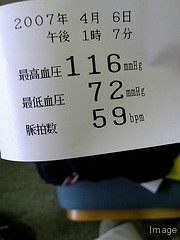Most people want to take good care of their bodies. We exercise, eat right and try to get good sleep. One thing some neglect, however, is getting their checkup. Usually with a checkup, or doctor visit, a patient’s blood pressure (BP or arterial blood pressure) will be checked.
It is recommended by the medical community to have your blood pressure checked at least every two years if your readings have been normal to that point (120/80 mm Hg). If they are a bit high, but not in the dangerous range, then they recommended at least a yearly check, if not more often. But if your blood pressure readings are consistently too high (hypertension), then the doctor will want to keep close tabs on your blood pressure and will possibly suggest a medication for treatment (beta blockers like Alprenolol, Bucindolol, Carteolol, Carvedilol, Labetalol, Nadolol, Oxprenolol, Penbutolol, Pindolol, Propranolol, Sotalol, Timolol, Acebutolol, Atenolol, Betaxolol, Bisoprolol, Celiprolol, Esmolol, Metoprolol, Nebivolol) to take and/or a health routine for you to follow.
Hypertension disease can lead to cardiovascular problems, increasing risk of kidney failure, heart attacks, aneurysm, heart failure, metabolic syndrome and even to troubles with memory.
The blood pressure can tell vital things about your health status. It will tell if the blood is pumping properly through your body, or if there is a stress on your body. When reading your blood pressure numbers it is usually displayed in a fraction type format with two numbers. The systolic pressure is listed on the top of the fraction and the diastolic on the bottom.
The systolic number refers to the time when the heart is contracting. It measures how well the blood is doing carrying oxygen and nutrients to the rest of the body, including the vital organs. The diastolic pressure is a reading of the pressure in the arteries when the heart is between beats.
The diastolic pressure can change frequently throughout the day. This can result from a change in posture, tension, the use of nicotine and also exercise. It is important to monitor your blood pressure readings at the same time every day in order to get a more accurate picture of what your numbers are running. Also, checking it frequently can give an idea of why your blood pressure may be falling or rising at different times in the day.
When the diastolic is too low, usually below 60, then the cells in the body are not receiving the oxygen needed, and waste material is not being expelled so cells can become damaged or die. If the diastolic pressure is too high, usually above 90, the body’s cells can become damaged and the vessels and arteries can harden. This can lead to damage or failure of a major organ, like the heart.
It can be relatively easy to check your blood pressure. Many local stores or pharmacies now house a blood pressure cuff in their lobby or store. If you verify that this machine is accurate, then use that same machine to check your blood pressure daily if you are having concerning readings, or even weekly. If you are having normal blood pressure and pulse readings, then you may just need to check it once a month or so.
Your doctor’s office will be happy to assist you in testing your reading, as well. Sometimes you can even ask to come in for the nurse to check it and not have to schedule an appointment. If they see a consistent problem, they may suggest you return for an appointment. You can even purchase a fairly inexpensive Omron blood pressure monitor at home and keep track that way. Whatever way you choose, be sure to keep on top of your blood pressure numbers.

Thanks for good article! I have a question for you. What to do if you have a low diastolic blood pressure? How to increase it? And what can happen?